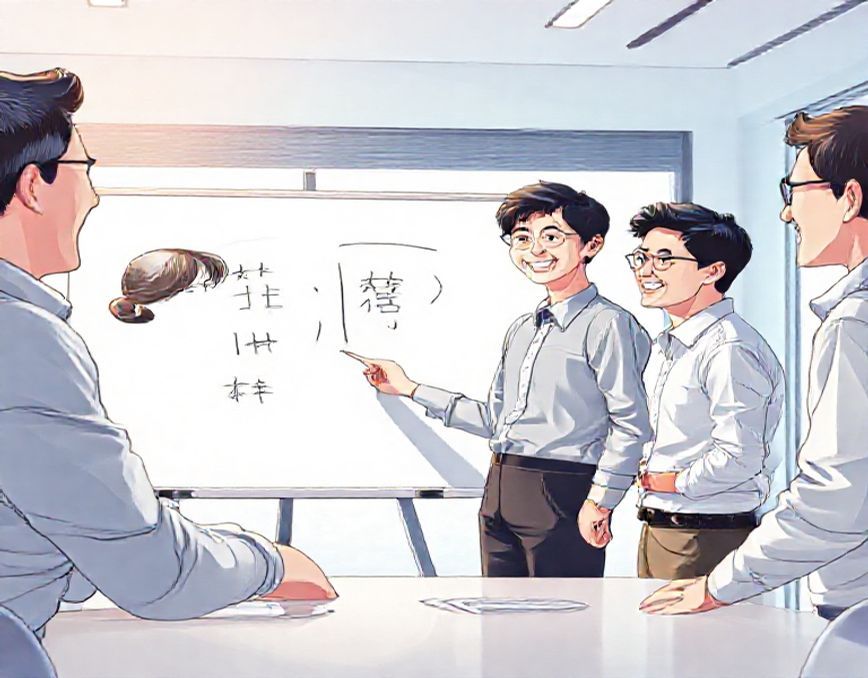
The 'Ugly Draft' Strategy: Unlocking Japan's「Tatakidai」Secret for Smooth Projects
Have you ever spent an entire week polishing a plan, a presentation, or a design? You meticulously check every comma, align every pixel, believing you're crafting a masterpiece. Then, filled with pride, you present it to your boss or team...
...only to be met with a barrage of feedback that makes you want to scrap it and start all over. 🤯
That feeling is truly painful and discouraging. But what if I told you that in Japan, there's a 'secret weapon' to transform this agonizing feedback process into a creative, collaborative session? Welcome to the world of 「たたき台」(Tatakidai) – the art of creating a draft that's 'ugly enough' to succeed.
🧐 What on Earth is a「たたき台」?
Literally, 叩き台 (Tatakidai) means a 'chopping block' or 'anvil'. Imagine a blacksmith placing a red-hot piece of iron on an anvil and striking it repeatedly with a hammer to shape it. The initial piece of iron might be rough and formless, but with each strike, it gradually becomes a sharp sword.
In the Japanese workplace, a 「たたき台」is that piece of iron. It's a rough sketch, a preliminary draft, a framework of initial ideas put forward not to be praised, but to be 'beaten,' criticized, dissected, and commented on without mercy. 🔨
It's the very first version of a document, plan, or proposal created with the explicit purpose of serving as a foundation for discussion and improvement.
✨ The Unbelievable Power of an 'Imperfect' Draft
It sounds counter-intuitive at first. Why would you intentionally create something that isn't perfect? But this very 'imperfection' is the golden key that unlocks numerous benefits:
-
✅ It Lowers Psychological Barriers:
- For the reviewer: When you receive a document that looks 100% perfect, you hesitate to offer dissenting opinions. You're afraid of disrespecting the creator's hard work or that your feedback isn't good enough. But when you receive a
tatakidaiwith the message, "This is just a first draft," you feel completely free to give honest, critical feedback. Everyone understands the goal is to improve it, not to judge its creator. - For the creator: You are freed from the pressure of perfectionism. Instead of wasting hours on minor details, you can quickly produce the main framework to gather opinions. This speeds up the work process incredibly. 🚀
- For the reviewer: When you receive a document that looks 100% perfect, you hesitate to offer dissenting opinions. You're afraid of disrespecting the creator's hard work or that your feedback isn't good enough. But when you receive a
-
🤝 It Fosters a Collaborative Spirit: A
tatakidaiis like an open invitation: "Here's my initial idea, let's work together to make it amazing!". It implicitly states that this isn't 'my product,' but 'our project.' This encourages everyone to participate, contribute their insights, and creates a sense of shared ownership over the final outcome. -
🎯 It's an Effective Form of "Nemawashi" (Laying the Groundwork): Instead of suddenly presenting a finalized plan in a major meeting, sending a
tatakidaito key stakeholders beforehand is an extremely skillful form of根回し(nemawashi). You can gather opinions, address potential concerns, and build consensus early on, ensuring that when the plan is officially proposed, it gets approved smoothly.
🗣️ How to Use「たたき台」in Real Life
This is an extremely common word in Japanese offices. You will frequently hear and use it in the following situations:
-
When presenting your first draft:
「たたき台として」 資料を作成しましたので、ご意見いただけますでしょうか。 Tatakidai toshite shiryō o sakusei shimashita node, goiken itadakemasu deshōka. (I've created this document as a rough draft, so could I please get your feedback?)
-
When your boss assigns a task and doesn't demand immediate perfection:
まずはたたきでいいから、明日までに一度見せてください。 Mazu wa tataki de ii kara, ashita made ni ichido misete kudasai. (Just a rough draft is fine for now, please show it to me once by tomorrow.)
-
During discussions:
このA案をたたき台にして、詳細を詰めていきましょう。 Kono A-an o tatakidai ni shite, shōsai o tsumete ikimashō. (Let's use this Plan A as a basis and hammer out the details.)
🧠 The Mindset Behind「たたき台」
The existence of tatakidai isn't just a work hack; it reflects a deep aspect of Japanese culture:
- Valuing the process over the initial result: The belief is that a great product comes not from a single genius, but from a collective process of improvement, contribution, and refinement.
- Humility and the collective spirit: Presenting a
tatakidaiis an act of humility, acknowledging that one's own idea isn't the best yet and requires the wisdom of others.
Next time you start a new project, don't try to create something perfect from the get-go. Try making a tatakidai and tell your colleagues, "This is just a draft, so feel free to strike away!". You'll be amazed at the change in your team's motivation and efficiency! 💪
Thẻ liên quan:
Lan tỏa kiến thức
Chia sẻ những điều hay ho với bạn bè